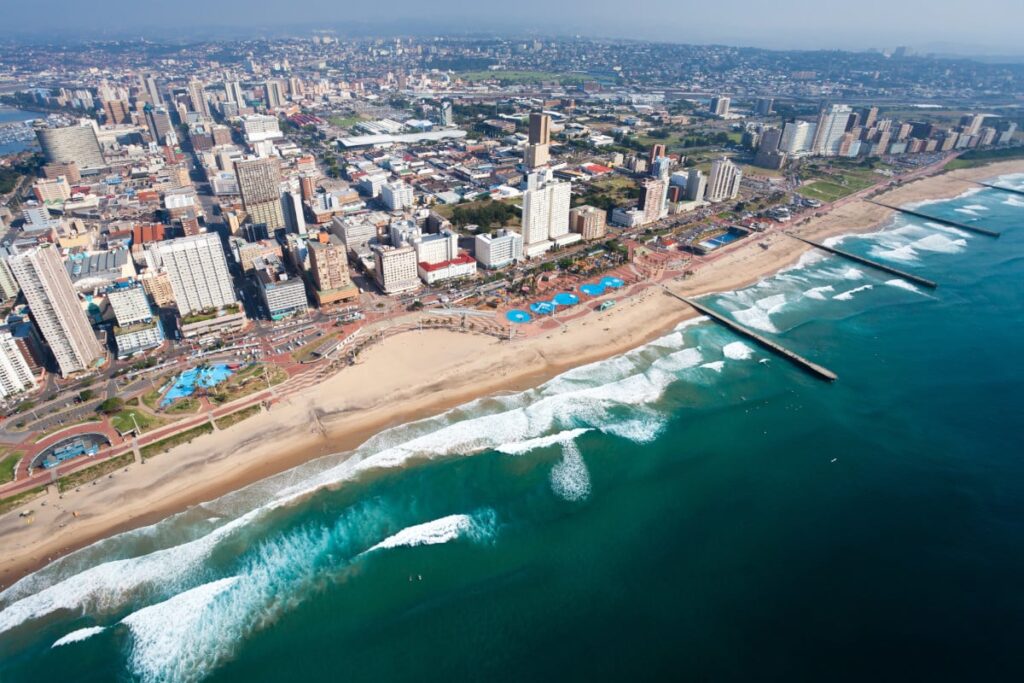1. Durban was originally called Terra do Natal by Vasco da Gama when he visited in 1497.

The first European to set foot on Durban soil was Portuguese explorer Vasco da Gama, who spotted this area from his ship on Christmas day while looking for a trade route to India.
He named the land “Terra do Natal”, Portuguese for Christmas Country. Hence the names “Natal” for the region and “Port Natal” for the settlement on its Indian Ocean seaboard, which came into existence in the early 1800s. Until that time the region remained off European radar until 1823 when Lieutenant F.G. Farewell’s ship sheltered from a storm here.
It has, however, a much longer history of habitation.
It is believed by archaeologists that this region, like most of South Africa, was inhabited by the San people, also known as Bushmen, as long ago as 100,000 BC.
These Bushmen, who were hunter-gatherers, were eventually displaced by the southward migrating Bantu tribes 500 – 1000 years ago. They are the ancestors of South Africa’s black population today.
2. It has the busiest container port in Africa and is the 9th largest harbor in the world.
The Port of Durban, commonly called Durban Harbour, is the largest and busiest shipping terminal in sub-Saharan Africa. It handles up to 31.4 million tons of cargo each year. It is the fourth largest container terminal in the Southern Hemisphere, handling approximately 4.5 million TEU in 2019.
3. The first steam railway in South Africa was opened in Durban in 1860.
In 1860, South Africa’s first steam train ran from central Durban to the Point, in the harbour area. The large Durban station that was built years later is still visible, in that its main building is preserved as a national monument.
4. Mahatma Gandhi, political activist and spiritual leader of the Indian independence movement actually started his political career in Durban when he arrived in 1893.
Mahatma Gandhi spent his formative years in South Africa, where he developed his philosophy of satyagraha, a form of active yet peaceful resistance to political injustices. The original Phoenix Settlement in Inanda, KwaZulu-Natal, was inspired by Gandhi, encapsulating his vision for a community based on self-reliance.
Mohandas Karamchand (Mahatma) Gandhi arrived in South Africa in 1893 aged 24 on an assignment as a newly qualified lawyer. He remained in the country for 21 years, occasionally visiting India and England. While living in South Africa, Gandhi was inspired by a visit to a Trappist community in Mariannhill and by John Ruskin’s book, Unto This Last, to find a communal living system. In 1904 he chose Phoenix to establish a community based on self-reliance and the value of labor on the land for the common good.
5. The Bunny Chow is typically representative of Durban – a hollowed-out loaf of bread filled with curry
Bunny chow, called a bunny for short, originated in the large Indian community of Durban, on the eastern coast of South Africa. Although various origin stories exist, they all have one thing in common: White bread was the only bread available with which Indian immigrants could eat their curries.
6. The world’s oldest and largest ultra-marathon, the Comrades Marathon, takes place here.
The oldest ultramarathon is the Comrades Marathon in South Africa, established on Empire Day, 24 May 1921, by First World War veteran Vic Clapham in memory of South African soldiers killed in World War I. It has been held annually ever since, apart from 1941–45 during World War II. It is also the largest ultramarathon, with typically around 20,00 entrants. The number for the 2015 Marathon was capped at 23,000 entrants. The race is approximately 90 km (56 miles) long and runs between Pietermaritzburg, the capital of KwaZulu-Natal Province, and Durban on the coast.
7. One of the top surfing destinations in South Africa
Sometimes referred to as the Bay of Plenty, Durban is a mecca for South African surfers. There is seldom a day when the wave is not working, and you can choose your spot according to the size of the swell. It gets bigger the further north you go, starting with beginner-friendly waves in front of uShaka Marine World and progressing to the pro-worthy left and right-hand breaks at New Pier. Keep an eye out for territorial locals at New Pier, Dairy, and North Beach.
8. The rickshaw was brought to Durban, in 1893, by the sugar baron Sir Marshall Campbell, from London.
Rickshaw pullers have been operating in Durban for more than 100 years. Rickshaws were brought into the KwaZulu-Natal province in 1893 by Sir Marshall Campbell (a sugar magnate) to provide comfortable transport for his wife. Today, this situation has changed dramatically as rickshaws are run by the Zulu population and incorporated into their culture, and cater specifically to tourists.
9. The town got its name from the former governor of the Cape Colony Sir Benjamin D’Urban in 1835.
On 23 June 1835 Port Natal was renamed Durban in honour of Sir Benjamin D’Urban, governor of the Cape Colony from 1834 – 37. It is thought that the first known inhabitants of the Durban area arrived from the north around 100,000 BC. Little is known of the history of the first residents, as there is no written history of the area before it was first mentioned by Portuguese explorer Vasco da Gama, who came to the KwaZulu-Natal coast while searching for a route from Europe to India.